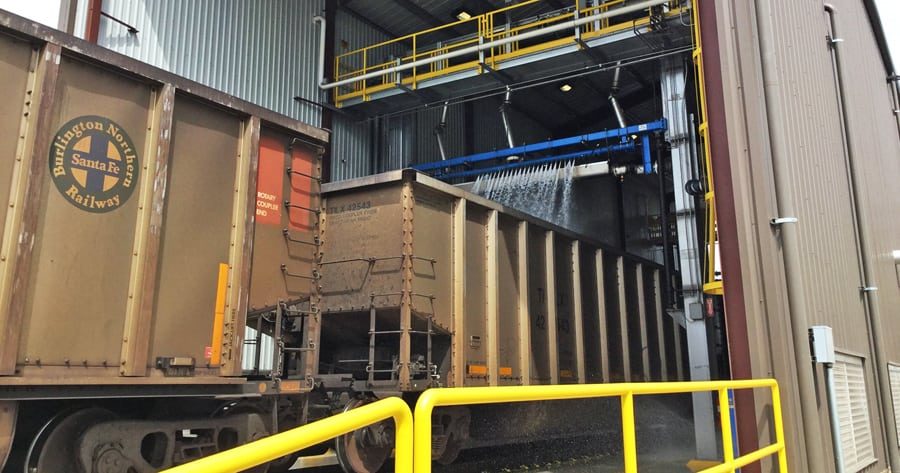
Home » BNSF builds $26 million coal dust suppression facility in Pasco
BNSF builds $26 million coal dust suppression facility in Pasco

June 15, 2016
By Jeff Morrow for TCAJOB
If the Millenium Bulk Terminal—a proposed facility in Longview—ever gets built, the BNSF Railway company will be ready to go.
Millenium is pushing to build a $680 million terminal to help transport coal to Asia. The proposed project is undergoing a state-required environmental impact study, which includes a public comment period with Cowlitz County and the Washington State Department of Ecology.
The plan calls for up to eight trains a day carrying coal from mines in Montana and Wyoming that travel to the terminal.
Those trains would pass through the Tri-Cities on their way to Longview and could have environmental impacts on the area.
Opponents, many from western Washington, are concerned about coal dust, the effects it would have on the health of Washington residents, and problems with climate change.
This is where BNSF Railway steps in.
The company built a $26 million high-speed coal dust suppression re-spray facility in 2015 in the Pasco hump yard in anticipation the Millenium project will eventually be approved.
The BNSF Pasco yard in Pasco, where train cars are transferred for their future destination, employs about 250 people.
Since Jan. 27, 2015, when the first train was sprayed, almost 1,000 trains have gone through the Pasco facility on their way to Vancouver, British Columbia.
The majority of those trains are filled with coal.
Only 20 people from outside the BNSF network have had access to tour the facility, and the TCAJOB was given an opportunity to view the building.
The facility is 30 feet tall and 25 feet wide. The height has to be above 22 feet so double-stacked train cars can get through.
As the train rumbles through at a top speed of 10 mph, sometimes slower, sprayers automatically drop or rise — depending on the train’s height — and distribute an equal amount of topper agent onto the coal in both volume and consistency.
While the building is open, the sprayers get closer to the car and are also protected from strong winds. Only the coal within the train cars is sprayed — not the cars or in between the cars.
Technology at the facility allows the sprayers to read how long each car is and then adjust the length of the spray.
“There is nothing like this is the world,” said Darrell Curilla, the chief designer of the facility project, which also includes a third main line. “There is one in Canada, but it is much smaller.”
Curilla said any product that misses a car lands on the floor, which has a covering and allows workers to recoup the lost product and re-use it.
The topper agent is one of seven approved by the government for use.
“What’s applied at the mine is also applied here,” Curilla said. “It’s rubberized and it’s totally inert. It’s not toxic and it doesn’t compromise the product.”
As the coal train leaves the mine, the same product is sprayed on the coal as the train leaves at a half-mile per hour.
In Pasco, the trains can be sprayed 20 times faster (at 10 mph).
“And it smells like kindergarten class in there — like Elmer’s Glue,” Curilla said.
Each time a train comes through, BNSF staff members, who are always on call, get emails with detailed reports about the train and how much product was used from the adjacent pump house.
Courtney Wallace, regional director of public affairs for BNSF, said the company didn’t have to build the facility.
“We are required by the federal government to haul regulated commodities. Our goal is to get products from point A to point B safely,” Wallace said. “But this (facility) is a condition of a request from our client for export in Vancouver, B.C. We took a look at it, and we decided it was the right thing to do. It adds another level of safety.”
Wallace said that BNSF is owned by Berkshire Hathaway, and ownership had to approve the project.
If approved, the Millenium project would increase the number of coal trains coming through Pasco.
But before that happens, the environmental review process needs to play out.
The public comment period started April 29 and ended June 13. Nearly 300,000 comments had been made concerning the project as of press time.
Through 2017, those comments will be considered and responded to. Additional studies will be done, if needed, and then the final EIS will be developed sometime in 2017.
If the project receives approval, the permitting process will begin.
On June 2, a final public hearing about the Millinium project took place at TRAC in Pasco. It lasted eight hours. Those who wished to share their comments to a board comprised of officials from Cowlitz County and the Department of Ecology were given two minutes.
Many of the speakers were in favor of the Millenium project, citing the addition of badly needed jobs in Cowlitz County. Others argued that coal dust is a health hazard and the project should be scrapped.
Many local politicians fell on the Millenium side of the argument. Larry Haler, a state representative from the Tri-Cities, was one.
“We need that project,” Haler said. “It would provide family-wage jobs. Communities across the state such as Longview need family-wage jobs. They buy cars, appliances, and they put their money back into the community.”
State representative Brad Klippert, of the Tri-Cities, agreed.
“I’m extremely thankful and supportive of what Millenium is doing in this state,” Klippert said. “Citizens want jobs, to support their families by going to work each day. Millenium is making that happen.”
Klippert said if the facility wasn’t built in Longview, it would be built in Vancouver, B.C., costing the U.S. jobs and other economic benefits.
Local News
KEYWORDS june 2016




